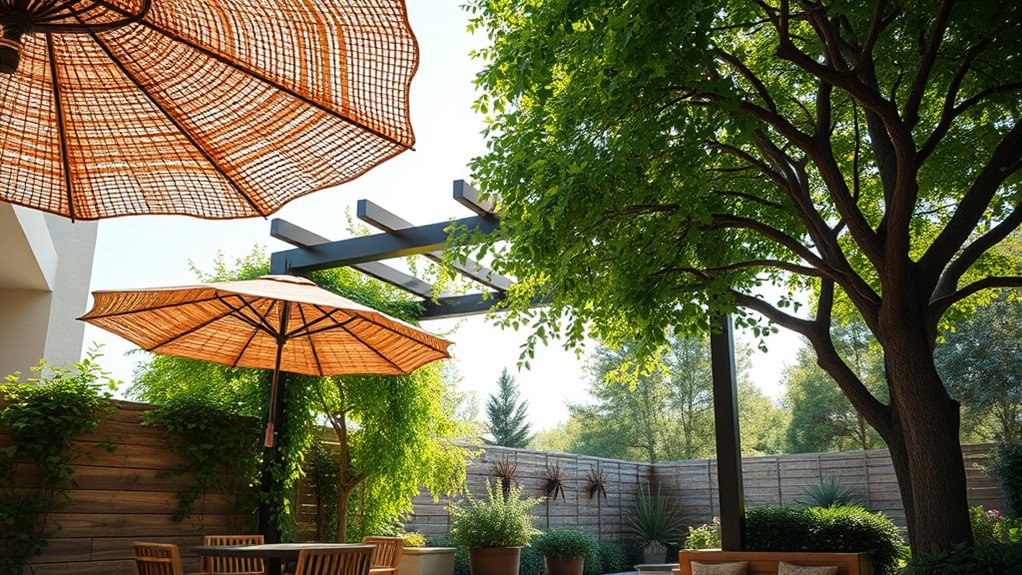To create a comfortable outdoor space, combine umbrellas, pergolas, and trees for layered shade. Use umbrellas for quick, portable relief, positioning them near seating areas. Install pergolas with retractable canopies or climbing plants to add style and permanent coverage. Plant large, deciduous trees to provide natural, cooling shade while allowing sunlight in winter. Mixing these strategies maximizes airflow and comfort while reducing heat. Explore more ways to enhance your outdoor retreat as you discover effective shade solutions.
Key Takeaways
- Combine umbrellas, pergolas, and trees for layered, effective outdoor shade and enhanced cooling.
- Use umbrellas for quick, portable shade near seating or dining areas.
- Incorporate pergolas with retractable canopies or plants to create permanent or semi-permanent shaded structures.
- Select trees with broad, dense canopies for natural, eco-friendly shade and temperature regulation.
- Strategically position and coordinate these elements to maximize airflow, sun protection, and outdoor comfort.

Have you ever wondered how to effectively beat the heat and protect your outdoor spaces from harsh sunlight? It’s a common concern, especially during those scorching summer days when the sun feels relentless. The key to staying comfortable lies in smart shade strategies that offer both sun protection and cooling techniques. By choosing the right solutions, you can create a shaded oasis that makes outdoor living enjoyable, regardless of how high the temperature rises.
Start by considering umbrellas. They’re versatile, portable, and quick to set up, making them ideal for adding immediate shade where you need it most. Look for large, sturdy umbrellas with UV protection coatings—they provide excellent sun protection and help block harmful rays. Tilt and rotate features allow you to adjust the shade as the sun moves, maximizing cooling techniques throughout the day. Positioning umbrellas strategically near seating areas, dining tables, or lounging spots ensures you get effective relief from direct sunlight, making your outdoor space more comfortable and inviting.
Consider versatile umbrellas with UV protection for quick, effective outdoor shade.
Pergolas are another excellent option for shade strategies. Unlike umbrellas, pergolas add a structural element to your yard, offering a semi-permanent solution that combines aesthetics with functionality. You can enhance their sun protection by adding retractable fabric canopies or climbing plants like vines or jasmine, which provide natural shade and coolness. Pergolas also facilitate airflow, which is a vital cooling technique—air circulation helps reduce ambient temperature and prevents that stuffy, overheated feeling often associated with outdoor spaces in the sun. They’re perfect for creating shaded walkways or cozy sitting areas, offering both style and relief from direct sunlight. Additionally, selecting materials that promote airflow, such as open lattice designs, can further enhance cooling.
Trees, however, provide perhaps the most natural and sustainable shade. When selecting trees for shade strategies, opt for species with broad, dense canopies that cast deep shadows. Deciduous trees are especially beneficial—they offer sun protection during summer while allowing sunlight to filter through in winter, helping you manage temperature year-round. Trees naturally cool the surrounding air through shade and evapotranspiration, making them an effective cooling technique. Plus, they add beauty and privacy to your outdoor space, creating a serene environment that’s both functional and visually appealing. Incorporating tree canopy management can optimize shade coverage and health.
Combining these shade strategies can yield the best results. For example, placing umbrellas under a pergola or planting trees nearby can maximize sun protection and cooling techniques, ensuring your outdoor space stays comfortable even on the hottest days. By thoughtfully integrating umbrellas, pergolas, and trees, you create a layered shading approach that not only blocks the sun but also promotes airflow and natural cooling. The right mix of shade strategies transforms your outdoor areas into cool, welcoming retreats where you can enjoy the sunshine without suffering from heat exhaustion or sunburn.
Frequently Asked Questions
What Are the Environmental Benefits of Different Shade Options?
Different shade options offer environmental benefits by reducing urban heat and lowering energy use. For example, trees increase air circulation and provide natural cooling, while pergolas and umbrellas reflect solar radiation, thanks to their solar reflectance properties. These strategies decrease reliance on air conditioning, cut down on greenhouse gases, and improve air quality. By choosing the right shade, you actively help create a cooler, healthier environment around you.
How Do Shade Strategies Impact Property Value?
Did you know properties with well-designed shade strategies can increase their value by up to 20%? Your shade customization enhances aesthetic appeal, making your outdoor space more inviting and functional. This improvement attracts potential buyers, signaling thoughtful landscape design. By investing in umbrellas, pergolas, or trees, you not only create comfort but also boost your property’s marketability and overall worth.
What Maintenance Is Required for Various Shade Structures?
You need to regularly inspect your shade structures to maintain their durability. For umbrellas, clean fabric and check for tears weekly, and store them during harsh weather. Pergolas and trees require pruning, and you should inspect for rot or pests seasonally. Establish maintenance schedules to ensure longevity; for example, treat wood pergolas annually and clean tree debris after storms. Proper upkeep preserves durability and keeps your shade structures looking their best.
Which Shade Method Is Most Cost-Effective Long-Term?
Think of your shade solution as planting a sturdy seed that grows over time. Among options, trees often offer the best long-term cost-effectiveness due to their durability and natural beauty. A thorough cost comparison and durability assessment show that trees, though initial investment is higher, save you money with minimal maintenance. Umbrellas and pergolas may be cheaper upfront but require ongoing upkeep, making trees the most sustainable choice for lasting shade.
How Can Shade Strategies Be Integrated Into Existing Landscapes?
You can integrate shade strategies into your existing landscape by analyzing shade patterns to understand sun exposure throughout the year. Incorporate seasonal plantings that thrive in partial shade to naturally enhance comfort and aesthetics. Consider adding movable umbrellas or pergolas that can be adjusted based on the season. These approaches create a seamless, functional shade environment that complements your landscape’s natural features.
Conclusion
Now that you know your options—umbrellas, pergolas, and trees—you’re like a gardener of comfort, shaping your outdoor oasis. Think of umbrellas as your quick, playful shade dancers; pergolas as elegant, sun-dappled courtyards; and trees as your wise, towering guardians. By choosing the right shade strategy, you craft a cozy sanctuary where every sunbeam is welcome, and every shadow feels like a gentle hug. Your perfect outdoor retreat is just a shade away.










